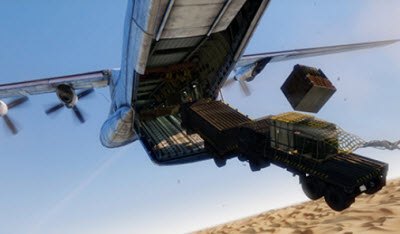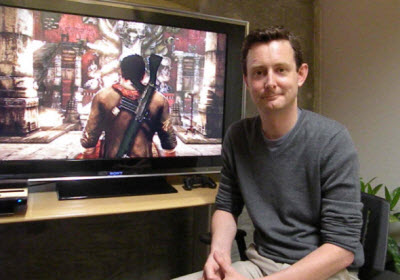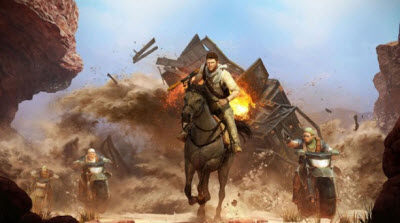VB: I actually thought the same guy was coming back over and over and over.
JR: Yeah, we have heard that before, and that is something we definitely need to address if we are going to do another one of these things. That is something we will look at.
 VB: Before we go into nitpicking these points, the game has received great reviews. I’m sure you guys must feel pretty good about it.
VB: Before we go into nitpicking these points, the game has received great reviews. I’m sure you guys must feel pretty good about it.
JR: Obviously we are happy that people want to follow us on another one of these adventures. It is always nerve-racking to put these things out and let your baby go and have people actually review it and play it and all that kind of stuff. But this year it has been overwhelmingly positive, and that is great. We are happy that the fans are happy.
VB: What would say was different about development this time?
JR: It was about the same size team, around 90 full-time developers and another 20 or 30 contractors. So the teams were roughly the same in size. But I think the biggest thing this time was just how much more we had to work to get the big custom set pieces (major scenes) done. We had to work more on the subtleties of the game so that we can make the game even better than last time. We had done so much work last time. Getting those last few things nailed down this time and getting the big set pieces to work the way you want them was very hard. We were going for a lot more nuanced stuff. That always takes a lot more time; and on top of that we are trying to do some very technically difficult set pieces.
And so I think the biggest thing in the process this time was just us trying to figure out bang for your buck. Was the scene worth it? What wasn’t worth it? We really went for it on scenes like the cruise ship. For example, we had to make sure that the waves hitting the cruise ship were right. You would have to flip over and fall 90 degrees or 180 degrees on the cruise ship, with this sense of vertigo. Those technical things were a lot scarier than they were last time. This time we just took it up a whole notch. At the same time, we were trying to make an interesting story and a nuanced story. That made development tricky. We had to make sure the game mechanics worked and we didn’t break our systems as they all came together.
 VB: Some people reading this may not have played the game yet. Would you describe what you call a “set piece”? What happens with the character of Drake in one of these scenes?
VB: Some people reading this may not have played the game yet. Would you describe what you call a “set piece”? What happens with the character of Drake in one of these scenes?
JR: One of the touchstone parts of Uncharted as a franchise is that you feel like you are playing in an action-adventure movie. What we try to do is we have this big amazing scenes that you would see in an action movie. In the previous game, it was a building falling down as a helicopter shot at you while you were inside the building, or the scene on the train where you were walking in a wobbly way on top of the train and were trying to shoot at the same time. In this one, it is the scene on the cruise ship where you are outrunning the rushing water and the scene on the cargo plane where you are trying to shoot while people are getting sucked out of the hole in the plane. Those scenes have Drake riding on a moving jeep so that he can jump on a moving plane as it’s about to take off. The plane crashes into the desert, and you play this sequence all in the real-time. The cruise ship is moving under Drake’s feet at the same time he is fighting the other enemies. The boat flips over, and you have to run on the side of the hallway.
VB: You’re pointing to some of the scenes that show the limits of what you can do. I think the physics of making the shooting work while you are actually falling off the plane or you are just like moving around on the cruise ship seems very difficult.
JR: Yeah, thank you for noticing that. It is tricky. That and the cruise ship and a couple of the scenes at the end of the game took a lot of work. You are still able to control Drake in the way that you want to, but it also feels like he is out of control when he is falling off the plane.
 VB: I assume that is one of the points where you’re really taxing the hardware of the PlayStation 3?
VB: I assume that is one of the points where you’re really taxing the hardware of the PlayStation 3?
JR: It is all taxing. I think the trick is to, at any given point, push it as hard as we can. We try to push the graphics really hard, and when you are on the third installment in a series you feel like you max out the hardware. On the boat, animating all of that stuff is hard. We use every single bit of the processing power that we possibly can. But after the game is done, then you go back and look at it. And then you find that we could have been more intelligent about how we did this. We could have optimized this better and tried to get even more power out of the machine.
VB: I think when we interviewed (Naughty Dog’s) Richard Lemarchand (pictured) last time, he was talking about the power of the box and said that the original Uncharted may have used like 30 percent of the Cell processor in the PS 3 and that the second time around it was more like 80 percent or 90 percent. What did you use this time?
JR: We were, at any given point, using 100 percent. We were using everything we possibly could. There is always room where you find something where you can do the processing in some different way to find more power. There are all of these different ways to squeeze more power out of the box.

